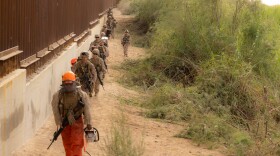I'm Maureen Cavanaugh it's Tuesday, April 5. Here are some of the San Diego stories we are following in the newsroom. A congressman wants the energy Department to hold a forum in Southern California where the San Onofre nuclear power frame -- powerplant is being dismantled. To discuss how we should handle nuclear waste. Darrell iso says residents are deeply concerned about the scheduled storage ability 4,000,000 pounds of high-level nuclear waste at the side of the train reactors which were closed permanently in 2013. Listen for the latest news through the day right here on KPBS. Our top story, the Buzz in San Diego is all about the charger's plan for a new downtown Stadium. If the Chargers do move downtown, what happens to the Qualcomm Stadium in mission Valley? A proposal to redevelop the site into a new sports and education complex was unveiled today at San Diego State University. KPBS Metro reporter, Andrew Bowen was there and he joins us now. What kind of redevelopment is being proposed is dating site? The presenters today stressed this is just a conceptual plan. Starting point to imagine what could be possible for this property. Under the plan, the Qualcomm Stadium currently would be demolished in a smaller stadium would be built in one of the corners of the property where the Aztecs would play. Resorted an open question whether or not major league soccer teams could eventually play there as well. The smaller stadium with it the Aztec fan base a but -- a bit better. When you have so many turning out for a football game ties that the best game day experience. They want to build housing for students and faculty of San Diego State and possibly use -- SDSU. That has the benefit of being close to the campus and having a trolley line that goes straight to San Diego state. They would restore the river and create a parked there. They would also -- create research facilities. Who is actually proposing's idea? The main presenter was the GMI Realty President John Kratzer. There were five men on stage and some of them were from other development firms. There was also Steve peace a former political -- state legislator. Political consultant. The event was organized by the San Diego state real estate program. Although, all on stage were quick to stress that this plan has not been endorsed by the San Diego State President, Elliot Hirshman. In it -- interestingly, the President did publish on his blog that he says -- he thinks mission Valley and the Stadium site is a huge opportunity for San Diego state. Fitting into its goals of being one of the top 50 research universities in the country. He didn't really endorse this plan in particular, but he did endorse all the ideas and concepts within the plan. Any estimates on how much would this -- this would cost? Their war -- there were initial assessments done on the property. To purchase it it would cost about $50 million in its current state. There would be 120 million more dollars that would be for demolishing the Stadium and Billy other infrastructure. To a total of $170 million. The former legislator, Steve peace, has been very vocal about his idea that the city of San Diego which owns the property should donate this to the University. Everyone pretty much agrees that education is one of the best investments financially and morally and culturally. The city to donate land to UC San Diego. Now I think people would agree, that was a forward thinking decision. It's one of the biggest drivers of economic growth. Of course that was in the 50s and it was a different time. Is this proposal tied in any way to the charger's plan for a downtown Stadium? Note one from the Chargers was on stage today. Someone the panel said they talked with the Chargers. John Kratzer, the President of GMI Realty says this has been discussed for a very long time behind-the-scenes. It was only after the Chargers officially abandoned mission Valley Stadium site -- they felt comfortable bringing these discussions into the public form. So it's not tied but it is innocence, coordinated. That's right. Any idea how this plan can move forward? It was introduced today. Where will it go from here? As I said in the conceptual's phase -- it's thinking about big ideas here. There is the citizens initiative that is currently gathering signatures and supported by former Councilwoman Donald -- Danielle Frye. That would set aside this property for educational and environmental purposes. There are a lot of hurdles to that passing. They have together signatures, it has to be certified if it's legal. And then it would actually have to pass about. And survived any potential legal challenges. There are a lot of gifts -- -- ifs. This will be a long ways away. I had been speaking with KPBS reporter Andrew Bowen. Thank you so much. Thank you.
A proposed expansion of San Diego State University onto the current Qualcomm Stadium site "could alter the trajectory of [the school's] history for the next several decades," SDSU President Elliot Hirshman said Tuesday.
Hirshman issued his first public comments on expansion at the same time that representatives of a developer held a town hall meeting about their vision for the 166-acre property in Mission Valley.
The officials with JMI Realty, Cisterra Development and others outlined a plan that includes research facilities that could be used by SDSU, UC San Diego and private entities; student and faculty housing for the two schools; a stadium for football and professional soccer; and 67 acres of open space along the San Diego River.
Their plans were conceptual in nature, with few details provided on costs or financing.
"SDSU West" would be located just a few miles from the main campus on Montezuma Mesa, and about a half-hour by trolley from UCSD, once the Blue Line extension is completed.
"The excitement and challenge of realizing such a vision will, of course, be in the details," Hirshman said in a post on the SDSU President blog.
"One especially exciting aspect, mentioned earlier, is that the Metropolitan Transit System's trolley provides a rapid, easily accessible connection between our campus and the Qualcomm site," Hirshman said. "This existing transportation infrastructure is critical to realizing a sustainable, green vision for the redeveloped site and for our entire university."
He said as more students and professors ride the trolley, traffic would be reduced in Mission Valley and the College Area.
The Mission Valley property has been eyed for years as a location for future university expansion, but such thoughts are closer to becoming reality now that the Chargers have decided to try to get a new stadium built downtown.
Hirshman remained mum while executives of San Diego's National Football League franchise pursued a move to Los Angeles County and ultimately turned their sights downtown.
The San Diego State football team has shared the Mission Valley stadium with the Chargers since the late 1960s, but the general consensus has been that the Aztecs don't want to follow their NFL counterparts farther away from campus.
The proposed new stadium would be located at the northeast corner of the property and would have a smaller seating capacity than Qualcomm Stadium, in an effort to capture a fan experience closer to what the Aztecs basketball team offers at Viejas Arena.
Hirshman noted that expansion into Mission Valley was a long-term project.
The Chargers' proposed move to downtown hinges on voter approval of a hotel room tax increase the would fund construction of an associated convention center annex, and cover land acquisition and moving costs. Team Chairman Dean Spanos also has an agreement to relocate his franchise to a future stadium in Inglewood, near the Los Angeles International Airport, if his San Diego plan doesn't work out.
Councilman Scott Sherman, who represents Mission Valley, called the expansion plans "an interesting idea" but said they put the "cart before the horse," since the Chargers' fate remains undecided.





